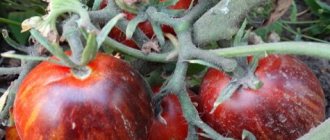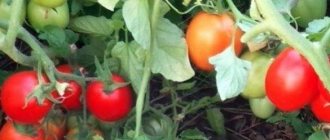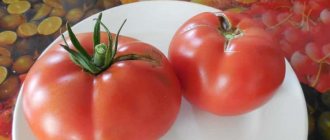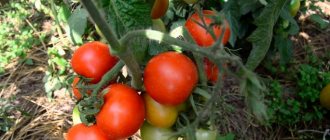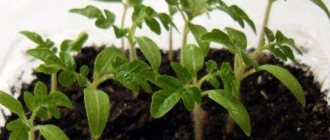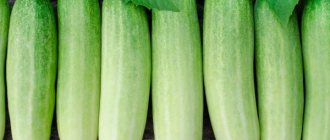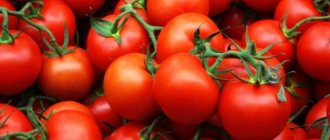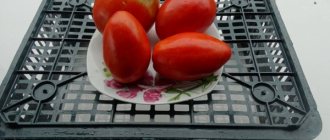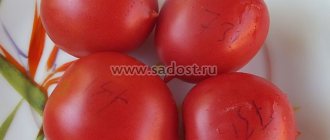The Potato Raspberry tomato is quite difficult to care for for inexperienced gardeners, but with experience and effort you can get a stunning harvest, because individual fruits can reach 800 grams. In addition, they have a wonderful taste.
| Height | Landing location | Ripening time | Fruit color | Fruit size | Origin | Fruit shape |
| Medium height | Greenhouse, Open ground | Mid-season | Pink | Large | Variety | Flat-round |
Plant characteristics
The bush grows in height from 1 to 1.2 meters. Each plant produces deep green leaves. The fruits are large, fleshy, and crimson in color when ripe. The weight of one tomato is from 600 to 800 grams. On each cluster of this plant, 3 to 6 tomatoes ripen, that is, 4-6 kilograms of harvest can be harvested from one bush. The fruits have a rich sugary taste.
Tomatoes are well suited for fresh consumption, making juice, sauces and winter preparations.
The shelf life of the harvested crop is short. The fruits of this variety are not suitable for long-distance transportation. Interesting! Farmers very rarely grow Potato Raspberry tomatoes due to poor storage.
Tomato Potato Raspberry
Description and characteristics of the Potato Raspberry tomato variety, reviews, photos
Mid-season, medium-growing, indeterminate tomato variety. Recommended for growing in open ground and in greenhouses.
The height of the bush in open ground is 1 meter; it requires tying to a support and pinching. This tomato has a potato leaf. The best results were obtained when forming a plant with 2-3 stems.
Basic qualities of fruits
photo author Evgeny Balashov
The fruits are large, flat-round, raspberry-colored at maturity, weighing up to 800 grams, tasty, sugary at the break. These tomatoes are good for fresh consumption, making juice and winter preparations.
Features of cultivation, planting and care
We recommend sowing Potato Raspberry tomato seeds for seedlings 60-65 days before the plants are supposed to be planted in the ground. Seedlings dive at the stage of two true leaves. When planting seedlings in a permanent place per 1 sq. It is recommended to place up to 3 plants per meter of land.
Further care for tomatoes consists of timely watering, fertilizing with complex mineral fertilizer, pinching and preventive measures to protect against diseases and pests.
How to form tomatoes, video
If you grew Potato Raspberry tomatoes, please write whether you liked them or not. What was the yield and taste of the fruits like under your climatic conditions? How do you rate the disease resistance of this variety? Briefly describe the advantages and disadvantages of this tomato in your opinion. If possible, attach a photo of your tomatoes to your comment. Thank you!
Your reviews of the Potato Raspberry tomato and additions to the description will help many gardeners evaluate this variety more objectively and decide whether it is worth planting or not.
Germination of seeds
Seeds are sown 2 months before planting in the ground. The optimal temperature for seed germination is 23–25°C.
Stages of work:
- to soak the seeds, use a saline solution (1 spoon of salt is dissolved in 1 liter of water), all seeds that float to the surface should be removed;
- before planting, 3–5 days before, it must be disinfected in a weak solution of potassium permanganate or hydrogen peroxide for half an hour and dried;
- to shorten the growing season to 75 days, pre-soak the seeds in a solution of a growth stimulator or aloe juice;
- You can germinate the seeds before planting, as it will be easier to care for the plant later.
For reference! To reap a good harvest, it is advisable to coordinate all planting work with the lunar sowing calendar.
Growing seedlings
For planting tomatoes, choose a sunny, well-heated place. When planting seedlings, 2-3 plants are usually placed per 1 m2 of plot. This scheme is considered optimal for obtaining a high yield (up to 18 kg). This variety is mid-season and usually takes 100–105 days from the moment the plant is planted until the fruits are fully ripened.
Stages of caring for seedlings:
- To form additional roots, transplant the seedlings into pots with soil 5 cm deeper than the previous containers.
- Water with warm water in the evening, as the soil dries.
- From time to time the soil is loosened.
- Weeds are removed as they grow.
- Spray the plant frequently.
- Fertilizers are applied 4-5 times per season, alternating organic matter with mineral fertilizers.
Be sure to pick up the seedlings. For the best harvest, only two branches are formed on the plant, leaving the main shoot and stepson in the upper axil, on the left or right. These actions are performed in the evening at moderate temperatures. Once a week, until the formation of an adult plant with flowering, it is advisable to disinfect it with a weak solution of potassium permanganate by spraying.
The bush is identerminate, standard. Near each plant you need to make several supports and tie up branches. This is done so that the plant does not break off under the weight of the fruits and the force of the wind.
Tomatoes of the Potato Raspberry variety are grown in greenhouses and open ground in the south of the country.
Important! The plant is light-loving, so it will be very difficult to grow it in the northern regions of the country.
Choosing a potato variety
There are a huge number of potato varieties, and each owner makes a choice based on his requirements
It is important to consider criteria such as:
- regionalization of the variety (potatoes must be adapted to the conditions of the area where they are grown);
- ripening time;
- productivity;
- resistance to diseases and pests;
- taste qualities.
For many, the criterion for the external attractiveness of the tubers is no less important, which is why many choose potatoes with a skin of a certain color.
ON A NOTE! For each region, potato varieties have been created and recommended that are specially acclimatized to certain conditions. You should take into account the recommendations of experts, but do not forget about the rules of agricultural technology.
Early and mid-late varieties are suitable for the middle zone, the territories of the North-West, Siberia, and the Urals. In the south, late potatoes are successfully grown, where they have time to fully ripen.
Early potatoes have a growing season of up to 80-90 days, which makes it possible to obtain full-fledged tubers already in mid-summer. But many varieties are not suitable for storage, which is why they are planted in small quantities, giving more space on the site to mid-late potatoes. Among the popular ones:
- Impala;
- Rosara;
- Bellarosa;
- Luck.
Varieties Nevsky, Gala, the popular Nevsky, and the beloved Charodey are mid-season varieties that are well stored and quite productive. Zhuravinka and Picasso will delight you with large and tasty tubers, but the long ripening period does not allow such potatoes to be grown in a number of regions of the country.
If we define varieties by region, then almost all varieties are suitable for the Black Earth Region: Rozara, Udacha, Lasunok, Golubizna, Resurs, Temp, Pobeda and many others.
For the humid and capricious climate of the North-West, Nevsky, Zhukovsky early, Latona, Nadezhda are suitable. In the Moscow region they grow the same Nevsky, Condor, Romano, White Spring, Timo Hankkiyan. Gardeners in Siberia and the Urals prefer the varieties Sante, Lyubava, Udache, and Governor.
Hardy Adretta, Bellarosa, Aspia, Titan grow even in unfavorable conditions, and with good care they show excellent results.
It is better to grow potatoes of different varieties on the plot, which will make it possible to get a guaranteed harvest in any season. An unsuccessful summer for one variety can be quite successful for another, so the hard-working gardener will be protected in any situation.
Cultivation care
The “Potato Raspberry” tomato variety needs to be watered twice a week. Make sure that there is no excess watering, as this can lead to plant disease and root rot. If the soil is not sufficiently moistened, all calcium from the fruit is transferred to the shoots. As a result, the bush grows, and practically no tomatoes are formed.
Plants need to be thinned out in a timely manner. To improve light transmission, it is necessary to remove the lower leaves and support the fruit clusters with slingshots. You can also open the plant to the sun's rays using spacers between the branches. By following these steps, you will help the fruits ripen earlier.
To obtain a high yield of this variety, regular fertilization is carried out:
- Add crushed eggshells and a small amount of Epsom salt at planting.
- Fertilizers based on seaweed and fish emulsion.
- Fertilize regularly with compost.
- For better fruit ripening, you need to spray with iodine solution. Add 25–30 drops of iodine tincture to a bucket of water. This solution can treat 1–2 square meters of area. Also, such irrigation helps to develop protective properties for the plant against the spread of late blight.
Advice! Nitrogen fertilizers are applied only when yellowness appears on the leaves of the plant. With an excess of nitrogen, not only intensive growth will be observed, but also poor fruit formation. If there is a purple tint on the leaves of the plant, add phosphorus. This fertilizer is responsible for the formation of fruits.
Mulching
For good plant development and fruit formation, you need to mulch the plants in a timely manner. When mulching, a protective layer of various types of mulch is formed on the soil surface.
The advantages of using this technique in growing varietal tomatoes:
- Allows you to reduce the number of waterings.
- Improves the structure and physical characteristics of the soil.
- Stops the growth of weeds.
- Protects against pests.
- Promotes the development of beneficial soil microflora.
- Prevents the development of certain types of disease.
- Increases yield.
Mulch comes in two types:
- inorganic;
- organic.
The first type includes polyethylene and nonwoven materials. The second type includes organic substances:
- crushed leaves;
- picked weeds;
- bark;
- compost;
- straw;
- branches;
- sawdust;
- hay.
Advice! It is advisable to plant plants with insecticidal properties near this variety of tomatoes. These include tansy, marigolds, and mustard. They can also be planted in the fall at the site of future planting of tomatoes, and then the greens can be used as mulch.
Hilling tomatoes
Many farmers are discussing the topic: “Is it necessary to hill up tomatoes?” you must decide for yourself what is best.
Advantages of hilling:
- the soil is well saturated with oxygen;
- the formation of additional roots improves, that is, the root system becomes stronger;
- in the furrows that were formed after applying this process, water accumulates after irrigation and is retained for a long time.
Disease susceptibility
Considering the description of experienced gardeners, a common disease of this species is fruit rot. All infected fruits should be picked and the application of fertilizers containing nitrogen should be reduced. It is advisable to treat the plants with the preparation “Hom”.
This plant is often parasitized by insect pests. The drug “Zubr” is used against melon aphids and garden cutworms. It is necessary to remove weeds where insect pest larvae can develop. The drug “Strela” is used against the cutting armyworm.
In the fight against mole crickets and slugs, which parasitize mainly in the central part of the country, an effective method is treatment with special preparations. For subsequent protection of plants from pests, traditional methods are used. For example, you can scatter crushed nut or egg shells around your plants to create a barrier for insects.
As with other hybrids, late blight often develops on this variety. To preserve the harvest, it is necessary to take preventive measures to protect the plant from this disease. For example, you can spray the bushes with a medicinal mixture. Mix 50 g of grated laundry soap (can be replaced with liquid soap) and the same amount of soda ash and add to a 10-liter bucket of water.
Advantages and disadvantages
Positive qualities of this type:
- the variety is safe for allergy sufferers;
- the fruits are quite large;
- taste qualities are excellent;
- used for food both fresh and for winter preparations;
- I grow it in open and closed ground;
- the variety is resistant to diseases;
- ripening is simultaneous;
- big harvest.
Disadvantages were also noted:
- a large root system needs a lot of space;
- it is necessary to form bushes;
- obtain large yields, possibly in open ground in warm regions; in cool climate zones they are grown in greenhouses;
- have a short shelf life;
- low transportability;
- require careful care.
Fact! Potato Raspberry tomatoes have a lot of sugar in their fruits! The plant is resistant to a variety of diseases.
Tomatoes with potato leaves: varieties, names, description, agricultural technology
Potato tomatoesHave you paid attention to tomato leaves? The leaf type can be very different among different varieties. For example, there is an ordinary leaf, a potato type and an intermediate one (typical of standard varieties). The common leaf is characterized by narrow lanceolate lobes
Particularly narrow leaf lobes are observed in varieties such as Champion of Buryatia and Argentine Miracle. There are even highly dissected, almost thread-like leaves, which is clearly seen in the example of the Taiyana variety. The leaves of this variety are similar to carrot leaves, which looks very unusual. The ordinary leaf shape is characteristic of the vast majority of varieties. The potato leaf type (photo 1), with a heart-shaped leaf lobe (like a potato), is determined by a weak - recessive gene, so there are very few such varieties. And we’ll talk about them today
The common leaf is characterized by narrow lanceolate lobes. Particularly narrow leaf lobes are observed in varieties such as Champion of Buryatia and Argentine Miracle. There are even highly dissected, almost thread-like leaves, which is clearly seen in the example of the Taiyana variety. The leaves of this variety are similar to carrot leaves, which looks very unusual. The ordinary leaf shape is characteristic of the vast majority of varieties. The potato leaf type (photo 1), with a heart-shaped leaf lobe (like a potato), is determined by a weak - recessive gene, so there are very few such varieties. And we will talk about them today.
American scientists have proven that varieties with potato-type leaves are more resistant to fungal diseases. Although, in fairness, I note that among potato-leaved varieties I know very unstable forms (the Lotus variety, which generally bears fruit poorly in open ground, but for the sake of the unusual white color and sweet taste of the fruit, I still grow it) and a lot of varieties with the usual type of leaf, which are highly resistant to late blight (for example, the familiar De Barao). However, for the most part, potato-type varieties are not only more resistant, but also often high-yielding. It is also believed that varieties with ordinary leaves transmit more light to the fruits and their fruits ripen faster because of this. However, in our hot conditions of recent years, this is also a big minus, since the fruits are already severely exposed to sunburn.
The first among all varieties with potato leaves, the Vintage Wine variety immediately comes to mind, already mentioned earlier in the article about striped tomatoes. I don’t know why it became my favorite, but I plant it every year. Apparently due to its unusualness in combination with large fruit. After all, I no longer have any other large-fruited ones (350-400g), with flat pink striped fruits, and even with potato-type leaves. Another very good and long-lived potato variety in my collection is Early Love. Of course, it is by no means the earliest, but it matures earlier than other giants. According to the type of bush, it is medium-sized (from 70 to 100 cm maximum). The fruits of this variety are exceptionally smooth, flat-round, pink, up to 400 g, with excellent sweet taste. High-yielding. Another variety with potato leaves, by the way, very popular among gardeners, is called Zorzha. This is a variety from the same group as Early Love. It is early ripening, gives a very abundant harvest. The fruits are soft pink, rounded-flat in shape, without a green spot on the stalk, weighing 200-300 g, one-dimensional, tasty, transportable, do not crack. The height of the bush is 50-70 cm, due to the abundance of fruits the bush lies on the ground, so the beds must be mulched, or to prevent the fruits from becoming dirty and rotting, tie them up. The next variety also deserves the highest rating and is called Denis. Just don’t confuse it with the low-growing pink-fruited variety of my selection. This Denis is from the USA. He's short. Its fruiting is of the cluster type - the fruits are collected on average 8 pieces per cluster. They are perfectly smooth, evenly red, without spots or burns, juicy, of good taste, weighing 80-100 g. Despite the fact that this variety is super early, its fruiting continues throughout the entire growing season - until frost. Its leaves are large, potato-like, emerald in color. The variety is widely used in breeding as a donor of resistance and intensive fruiting.
https://7ogorod.ru/pomidory/sorta-s-kartofelnym-listom.htmlhttps://ogorod-bez-hlopot.ru/tomat-kartofelnyj-malinovyj.htmlhttps://vk.com/topic-20013202_24509332
Harvesting and storage
This variety has a significant advantage over other types of tomatoes - it is the simultaneous ripeness of the fruit. Therefore, the harvest is faster. After harvesting, it is recommended to immediately consume fresh tomatoes to enjoy all the flavors. You can collect unripe fruits if cold threatens. They will ripen on the windowsill.
Before storing, you need to wash and dry the fruits well. Unfortunately, the fruits of this variety cannot be stored for a long time.
Classifications of early varieties
All crop varieties can be divided into two main types: domestic and imported. It may happen that imported potatoes will produce a less rich harvest than domestic ones.
Early potatoes
The crop can also be classified according to its ripening period. Ripening is considered the period of time from the first shoots to the moment of harvesting.
Only the early ones have several divisions:
- ultra-early 45-55 days;
- early ripening 50-60 days;
- mid-early 60-85 days.
In the southern region, early and ultra-early potatoes grow well, which ripen before the heat begins.
Vegetables can also be classified according to the purpose of cultivation:
- table - used for preparing dishes;
- technical - starch and alcohol are produced from it;
- fodder – used for feeding livestock;
- universal - something between technical and stern.
Any early variety can be classified according to its purpose. Early potatoes are good for eating in summer.
Ultra early
Ultra-early (super-early) is resistant to diseases, produces a good harvest and has a short growing season of ripening.
Early ones should be planted in late April-early May, as soon as the soil has warmed to a temperature of 8-10 degrees. To keep potatoes for a long time, you should wait until the skin becomes thicker.
Ultra-early varieties ripen on average within 50 days. This potato variety is a real find for amateur farmers. The tubers contain many nutrients, are smooth, tasty and have a good presentation for sale.
The most popular ultra-early ones: “Riviera”, “Karatop”, “Timo”.
Early ripening
Early ripening ones can begin to be dug up after 40-45 days. The variety Zhukovsky early is especially popular. The tubers are large, smooth, elongated, and the flesh is creamy.
The only thing is that early ripening varieties have a small percentage of starch; they remain hard during cooking. Preparations for planting begin in early April, a month before planting in open soil. At the beginning of May, tubers with sprouts can already be planted in the soil.
The fruit has a beautiful appearance and has amazing taste properties. During periods of frost, they tolerate wintering well. In one season you can get 2 harvests.
Mid-early
Mid-early table fruits are intended for consumption as food and animal feed.
The fruits ripen already on the 60th day. Potatoes of this classification are well resistant to many infections, except late blight. Suitable for sale due to its aesthetic appearance. Has excellent taste.
Reviews from gardeners
Irina Kuzminichna, 71 years old. Saratov region:
“I’ve been growing this variety of tomatoes for a long time and never cease to be happy. The harvest is always greater than expected. The taste is ideal. Many neighbors in the country also started growing the Potato Raspberry variety.”
Vera Alekseevna, 52 years old. Stavropol region village Soldato-Alexandrovskoe:
“I tried to plant this tomato variety from seedlings that my daughter bought at the market. I never believed the advertisements, but a miracle happened here. Beautiful pink-crimson, fleshy fruits have grown. Eating a salad from them is a pleasure. Now I will definitely plant this variety in the new season.”
Considering all of the above, this variety is well suited for growing for experienced gardeners! For those new to gardening, it is better to try a different variety of tomatoes that is easier to care for. But if you are confident in your abilities, then you can grow this capricious plant. It, in turn, will delight you with a bountiful harvest!
Variety "Adirondack Blue"
The name in its homeland is Adirondack Blue. Bred at Cornell University. It is distinguished by its highest yield and oval-rounded fruits, the average weight of which is about 100 g. The best purple chips can be obtained from the tubers of this variety. Ripening time is average - about 95 days. It is not resistant to diseases and has an average shelf life. But it contains enough antioxidants to make it preferable to traditional neutral-colored potatoes.
Should you grow purple potatoes? Definitely yes. And even if you don’t have room to roam around on your property, and no room for experiments, select a bed for a vegetable of a new color, displacing the good old potatoes. Select variety and ripening time. For example, if you traditionally grow a specific variety of winter potatoes, plant several rows of purple early ripening ones. And see what happens.
Already today there are private farms (not industrial ones) that have switched entirely to growing colored potatoes. It doesn't have to be purple. There are pink, blue, orange varieties. Each of them has its own exceptional beneficial properties. And the table and menu become more interesting, colorful and festive. Color is health. Why not grow a healthy product, even if it is an unusual purple color?!
